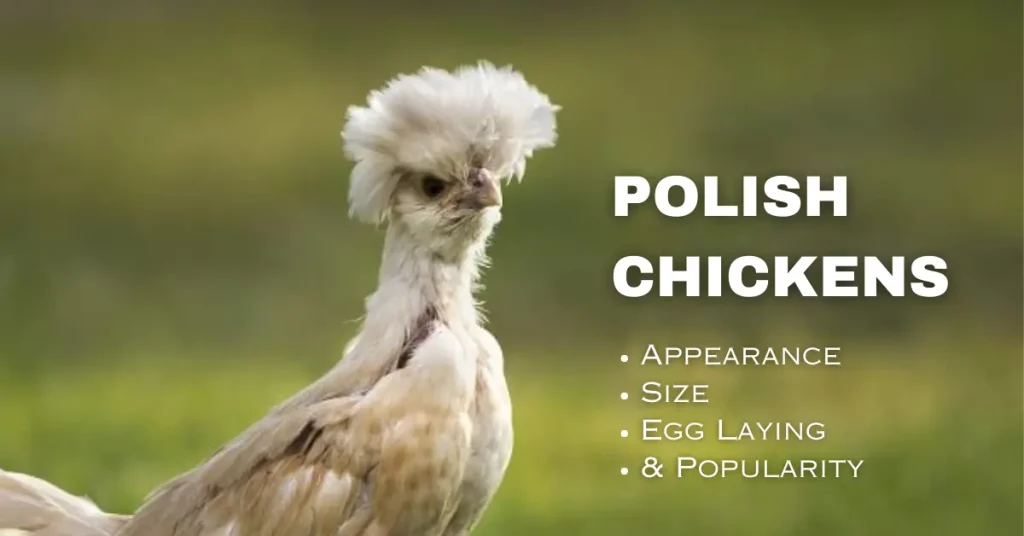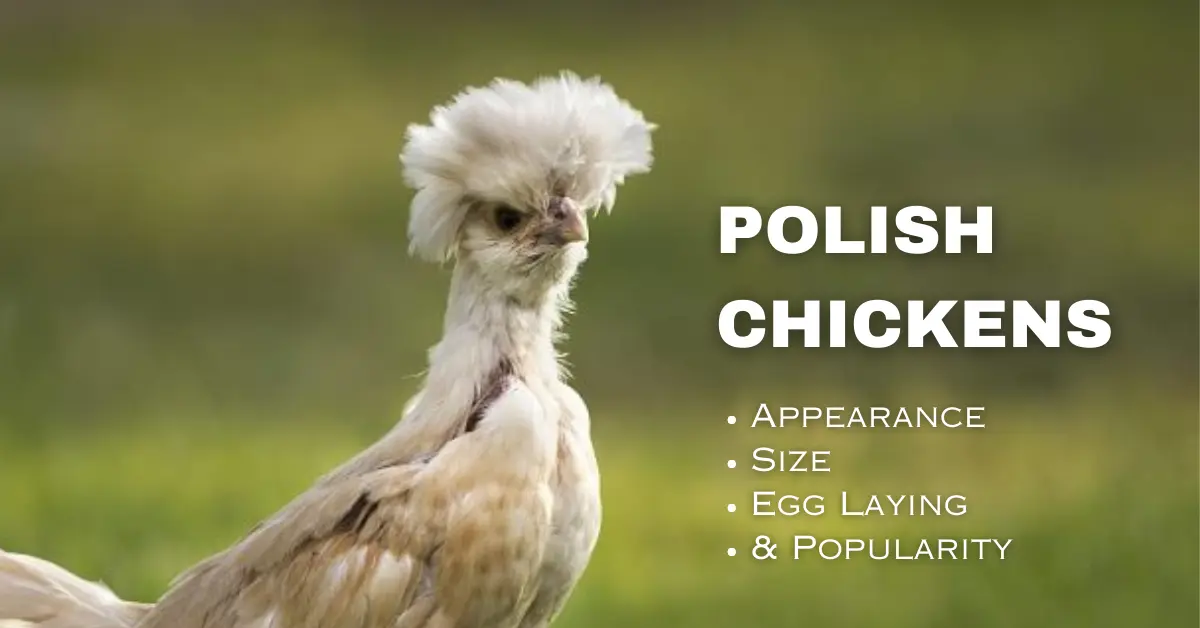Welcome to our comprehensive guide on Polish Chickens, one of the most distinctive and fascinating breeds in the world of poultry. Known for their unique crests and friendly personalities, Polish Chickens have captured the hearts of poultry enthusiasts worldwide.
Whether you’re an experienced poultry keeper looking to diversify your flock or a beginner venturing into backyard chicken keeping, this guide is designed to provide you with all the information you need about this unique breed.
We’ve covered you, from their rich history and distinctive characteristics to their care requirements and breeding tips.
In this guide, we’ll explore the origins of the Polish Chicken, delve into their unique physical attributes, and discuss their temperament and behavior. We’ll also provide a comprehensive care guide, including feeding, housing, and health maintenance tips.
We’ll provide a step-by-step guide for those interested in breeding these beautiful birds to help you get started.
So, without further ado, let’s dive into the fascinating world of Polish Chickens!
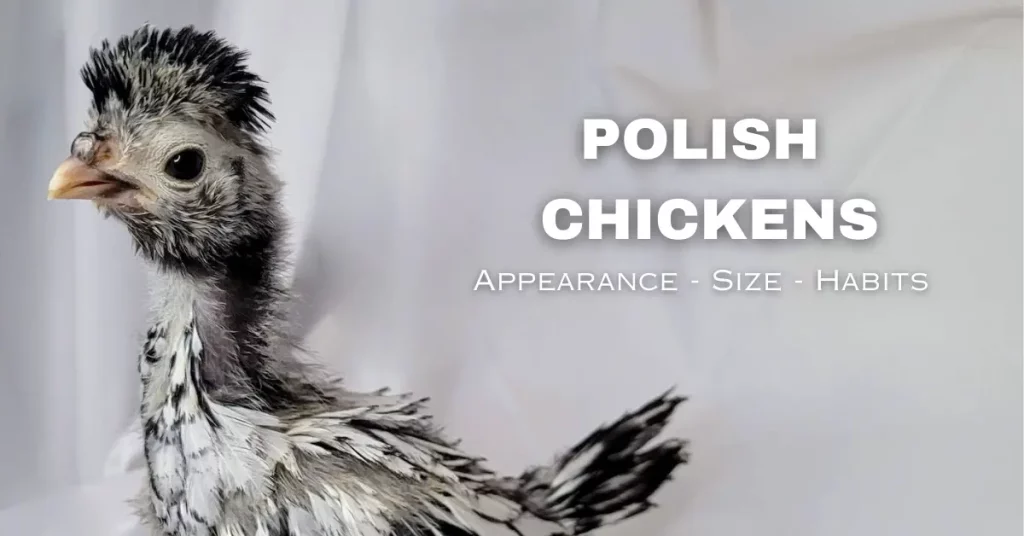
Table of Contents
ToggleDetailed History of Polish Chickens
Polish Chickens detailed history and how it rose to popularity among major European countries:
Origins and Early History:
Polish Chickens, also known as Poland chickens, have a rich and intriguing history that dates back centuries. While their name might suggest a Polish origin, it’s widely believed that they originated in the Netherlands or Spain. These birds were brought to Poland by traders, where they were further developed and refined, eventually gaining the distinctive features we associate with the breed today.
Popularity in Europe:
The 16th century marked a significant period for Polish Chickens as they gained immense popularity across Europe. Their unique appearance, characterized by their large crests, made them a favorite among poultry enthusiasts.
Moreover, their egg-laying abilities were highly valued, making them popular among farmers seeking aesthetic appeal and productivity.
Introduction to North America:
The journey of Polish Chickens continued across the Atlantic, with the breed being introduced to North America in the early 1800s. European settlers, who admired their unique appearance and egg-laying capabilities, brought them over. The breed quickly gained popularity, becoming a staple in many North American farms and homesteads.
However, the introduction of the Leghorn breed, known for its superior egg-laying abilities, led to a decline in the popularity of Polish Chickens. Today, they are listed on the Watch list of The Livestock Conservancy, indicating their rarity and the need for preservation efforts.
Comprehensive Characteristics of Polish Chickens
How Polish Chickens look alike, what they like, and detailed information about their temperament and behavior as well as their egg-laying capabilities:
Physical Appearance and Unique Features:
Polish Chickens are renowned for their distinctive appearance, which sets them apart from other chicken breeds like Saphire Gem and Sebright. They possess a small, rounded body, but the large, fluffy crest on their head makes them stand out. This crest, a puff of feathers in various colors, including white, black, and gold, gives them a regal and unique appearance.
Their feathers are smooth and shiny, adding to their ornamental appeal. They also have a V-shaped comb, often hidden by the crest, and small, rounded wattles. Their slender necks and legs further contribute to their distinctive look.
Temperament and Behavior:
Polish Chickens are not just about looks; they also have delightful personalities. They are known for their friendly and docile nature, making them excellent family pets. They enjoy human interaction and are known to be quite friendly.
However, they can be easily startled due to their limited vision caused by their crest, so it’s important to handle them gently and approach them in a way that they can see you coming.
Egg-Laying Capabilities and Production Rate:
While Polish Chickens are not primarily known for their egg-laying abilities today, they still lay many eggs. They produce medium-sized white eggs, and on average, they will lay around 150 eggs yearly.
Despite not being the most prolific layers, they are still popular among chicken enthusiasts for their unique appearance and friendly demeanor.
The Joy of Owning a Polish Chicken
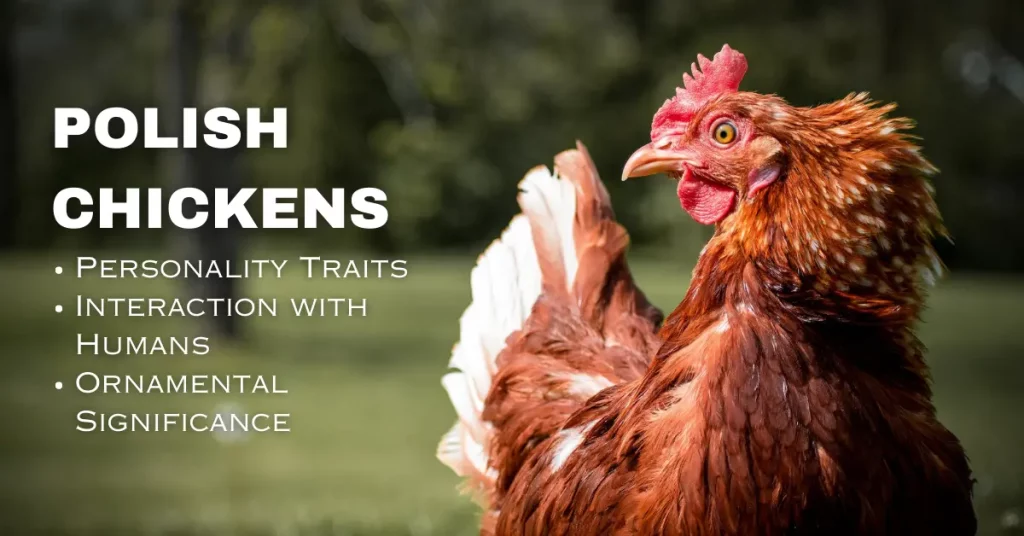
Owning a Polish Chicken is a unique experience that brings joy and entertainment to any chicken enthusiast. Their distinctive looks and charming personalities make them a delightful addition to any flock.
Personality Traits and Noise Levels
Polish Chickens are known for their friendly and docile nature. They are generally quiet birds, making them suitable for urban or suburban settings where noise can be a concern. They enjoy human interaction and are known to be quite friendly.
They are also known for being good with children and other animals, making them a great choice for families.
Interaction with Humans and Other Animals
Polish Chickens are quite friendly and enjoy interacting with their human caregivers. They are known to be quite tame and can often be found following their owners around the yard. They also get along with other animals and coexist peacefully with chicken breeds in a mixed flock.
Entertainment Value and Ornamental Significance
Polish Chickens are a sight to behold with their unique crests and striking appearance. They add an ornamental value to any backyard or farm and are sure to attract attention. Their curious and friendly nature also provides endless entertainment.
Watching them explore their surroundings or interact with each other can be a delightful pastime for any chicken enthusiast.
Complete Care Guide for Polish Chickens
Caring for Polish Chickens involves understanding their unique needs and providing an environment that allows them to thrive. Here’s a comprehensive guide to help you ensure your Polish Chickens are healthy and happy.
Health Issues and Prevention
Polish Chickens are generally healthy birds, but like any chicken breed, they can be susceptible to common poultry diseases. Regular health checks and a clean environment can help prevent most health issues.
Common health issues include mites, lice, worms, and respiratory infections. Practicing good biosecurity, such as quarantining new birds before introducing them to your flock, can help prevent the spread of diseases. It’s also recommended to purchase day-old chicks from a certified disease-free hatchery to ensure the health of your flock.
Feeding Requirements and Nutrition
Polish Chickens require a balanced diet to stay healthy and productive. For optimal egg production, a commercial layer feed will provide the necessary nutrients for hens. This should be supplemented with calcium sources like oyster shells for strong eggshells.
It’s also important to provide fresh water at all times and to clean it regularly to prevent algae and bacteria growth. Treats such as strawberries, apples, and celery can also be given in moderation but should not make up more than 9% of their diet.
Ideal Coop Setup and Housing Conditions
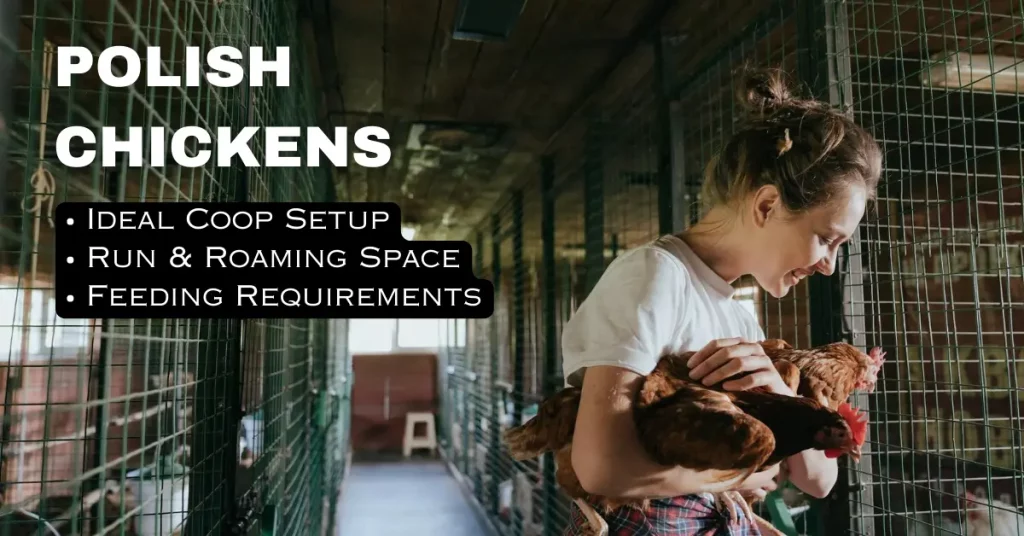
Polish Chickens require a secure and comfortable coop to protect them from predators and harsh weather conditions. A good rule of thumb is to provide at least 4 square feet of space per adult bird in the chicken house. The coop should also have good ventilation to prevent the build-up of ammonia and other harmful gases.
Inside the coop, provide roosting bars for the chickens to sleep on and nesting boxes for the hens to lay their eggs. Regularly cleaning the coop and replacing the bedding is crucial to maintaining a healthy living environment.
Importance of Run and Roaming Space
While Polish Chickens enjoy exploring and foraging, their crest can obscure their vision of predators, making them vulnerable in a free-range environment. Therefore, they should have access to the outdoors in a run covered with chicken wire. This provides them with a safe space to roam, forage, and exercise while being protected from predators.
Breeding Polish Chickens: A Comprehensive Guide
Breeding Polish Chickens can be a rewarding experience, allowing you to contribute to preserving this unique breed. Here’s a step-by-step guide to help you get started.
Selecting Breeding Stock:
When selecting breeding stock, choosing healthy and genetically diverse birds is important. Look for birds that exhibit the desired traits, such as crest size and shape, feather quality, and body type. Avoid birds that have any signs of illness or deformities.
Incubation and Hatching Process:
Once you have collected the eggs, they must be incubated for about 21 days. You can use a broody hen or an incubator for this process. If you’re using an incubator, maintain the right temperature and humidity levels, and turn the eggs regularly for even development.
Raising Chicks:
After the chicks hatch, they will need a warm and safe environment. A brooder with a heat lamp will provide warmth for the first few weeks. Provide chick starter feed and fresh water at all times. Monitor the chicks regularly for any signs of illness or discomfort.
Challenges and Solutions in Raising Polish Chickens
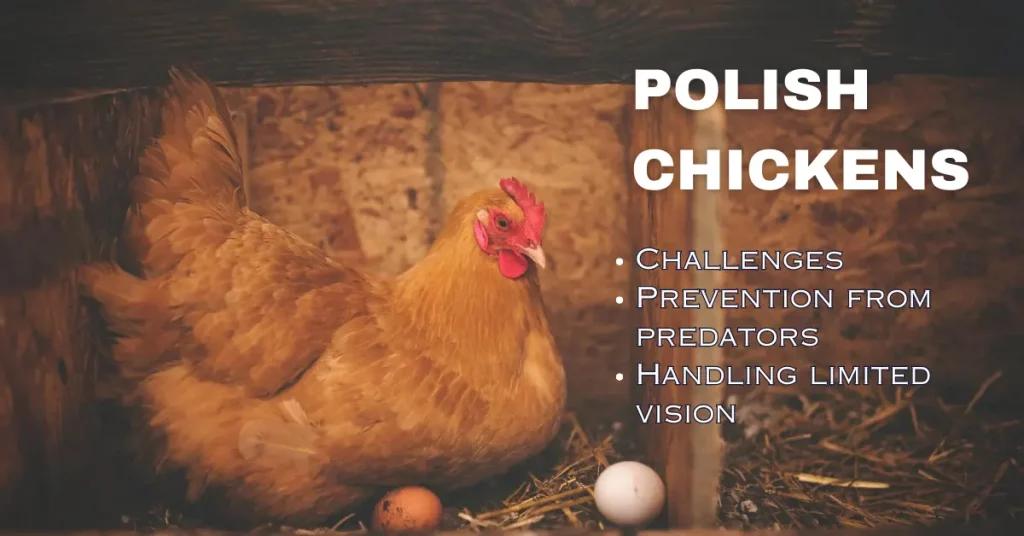
Raising Polish Chickens comes with challenges, but with the right knowledge and preparation, these can be easily managed. Here are some common challenges and their solutions.
Predation Prevention and Safety Measures
Due to their crests obscuring their vision, Polish Chickens are more vulnerable to predators. To protect your flock, ensure the chicken coop and run are secure. Use chicken wire or hardware cloth to cover any openings, and consider installing a predator-proof latch on the coop door.
Handling Limited Vision Due to Crests
The crest of a Polish Chicken can sometimes obstruct their vision, making them more prone to accidents or attacks from predators. Regular trimming of the feathers around their eyes can help improve their vision. However, care should be taken not to hurt the bird during trimming.
Weather Considerations and Cold Hardiness
Polish Chickens are fairly hardy, but their large crests can get wet and freeze in cold weather, leading to frostbite. To prevent this issue, consider providing extra heating in the coop or trimming their crests in cold climates.
Why Choose Polish Chickens for Your Flock?
Polish Chickens are a unique breed that brings a lot of value to any flock. Here are some reasons to consider adding them to your backyard or farm.
Benefits and Advantages of Raising Polish Chickens
Polish Chickens are visually appealing and have a friendly and docile nature, making them excellent pets. They are generally quiet birds, suitable for urban or suburban settings where noise can be a concern. Despite not being the most prolific layers, they still lay a decent number of eggs, adding productivity to their ornamental value.
Comparisons with Other Breeds
Compared to other breeds, Polish Chickens stand out due to their unique crests and various color patterns. While they may not lay as many eggs as some breeds, they make up for it with their friendly nature and ornamental value.
Testimonials from Polish Chicken Owners
Many Polish Chicken owners rave about their friendly and pleasant nature. They are known to be great with kids and can be quite entertaining with their unique looks and curious behavior.
Frequently Asked Questions about Polish Chickens
Are Polish Chickens good layers?
While Polish Chickens are not the most prolific layers, they still lay a decent number of eggs. On average, they can lay around 150 medium-sized white eggs per year.
Can Polish Chickens see with their crest?
The crest of a Polish Chicken can sometimes obstruct their vision. Regular trimming of the feathers around their eyes can help improve their vision.
Are Polish Chickens good for beginners?
Yes, Polish Chickens are generally easy to care for, making them suitable for beginners. However, their crests require additional care, such as regular trimming and protection from cold weather.
Can Polish Chickens live with other breeds?
Yes, Polish Chickens are known to be peaceful and can coexist with other chicken breeds. However, their limited vision might make them more vulnerable to bullying. It is important to monitor their interactions with other chickens, especially when introducing new birds.
Conclusion
Polish Chickens are a unique breed that brings beauty, personality, and history to any backyard or farm. Their distinctive crests, friendly nature, and fascinating history make them a joy to own and a delight to observe.
While they may require some additional care due to their crests, the joy of owning a Polish Chicken makes it all worthwhile. Whether you’re an experienced poultry keeper or a beginner, Polish Chickens can be a wonderful addition to your flock.
We hope this comprehensive guide has provided you with valuable insights into the world of Polish Chickens. From their history and characteristics to their care requirements and breeding tips, we’ve covered everything you need to know about this unique breed.
Author
-

He has a background in environmental science and specializes in creating content about renewable energy, green transportation, and climate change. Ryan's writing is known for its engaging and easy-to-understand approach, making complex topics accessible to a wide audience.
[email protected] Lee Ryan

